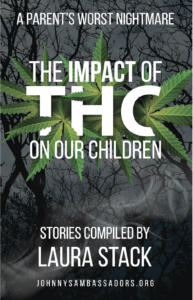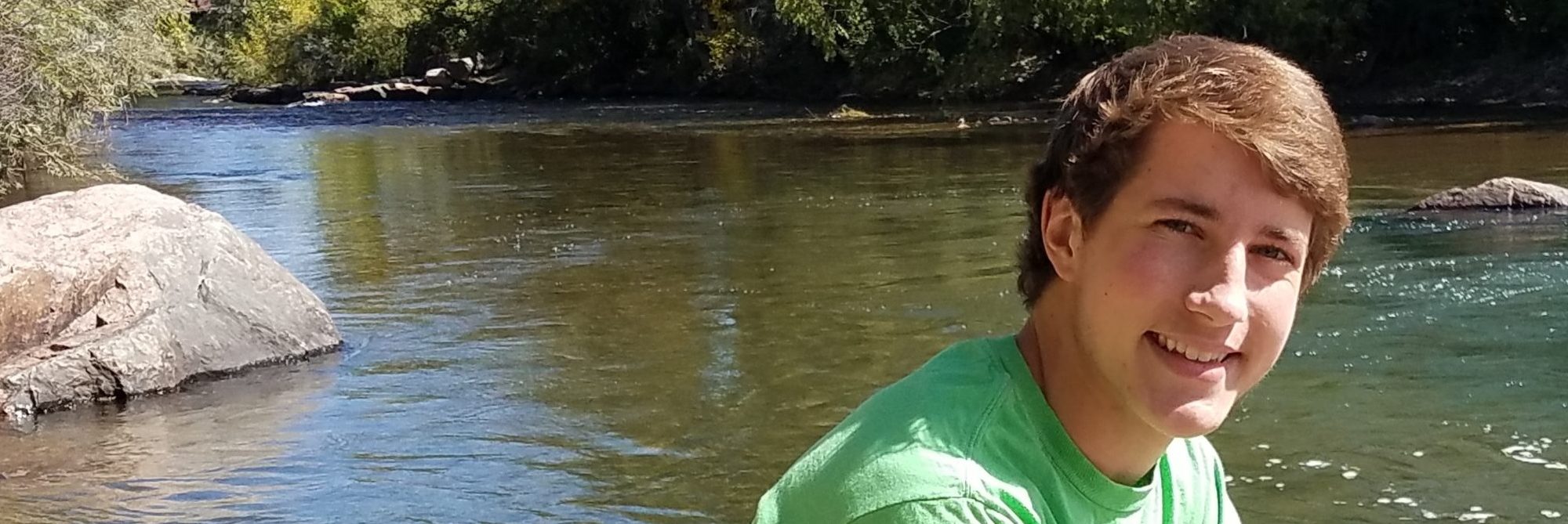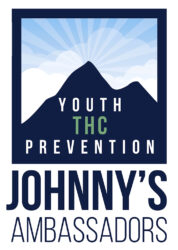by Tal Gur

What happens when a harmless puff turns into a life-altering crisis?
In The Impact of THC on Our Children: A Parent’s Worst Nightmare, Laura Stack weaves together 25 heart-wrenching narratives that shine a spotlight on the hidden dangers of today’s potent THC products—and why every parent needs to pay attention.
What is the Book About?
The book is a deeply moving collection of real stories from parents whose children have suffered serious consequences—psychosis, addiction, mental health decline, and in tragic cases, suicide—after using high-potency THC. Each chapter gives voice to families swept into a nightmare, as they recount the day-to-day unraveling of their children’s lives and the struggles to regain control amid confusion and despair.
More than a cautionary tale, this work serves as a call to action. Compiled by Stack and published through her nonprofit, Johnny’s Ambassadors, it seeks to educate parents, teens, and communities about the profound risks linked to modern THC products. With legalization altering perceptions, this book emphasizes that no level of THC is safe for adolescent brains—and urges vigilance before it’s too late.
Book Details
Print length: 236 pages
Language: English
Publication date: May 8, 2024
Genre: Non-fiction, Parenting & Families, Health & Wellness
Book Author
Laura Stack is an accomplished speaker and bestselling author, best known as “The Productivity Pro.” Yet nothing prepared her for the heartbreak when her son Johnny died by suicide after suffering cannabis-induced psychosis. Holding a deep personal stake, she channeled her grief into action—founding Johnny’s Ambassadors to educate others. Her powerful blend of empathy, credibility, and storytelling makes this book both authoritative and profoundly human.
Core Theme
At its heart, the book argues that today’s THC products—like vapes and concentrates—are not the benign substances some imagine. Their staggering potency (in some cases 60–90% THC) poses serious developmental risks to adolescent brains, leading to psychosis, anxiety, depression, addiction, and even suicide. Through these narratives, Stack uncovers how quickly experimentation can spiral into mental health crises.
Beyond the personal accounts, Stack makes a larger case: the legal and cultural normalization of high-THC cannabis fosters misconceptions about safety. The book urges parents to recognize that THC isn’t just a passing trend—it can profoundly damage young lives. With science-based insights and emotional storytelling, Stack invites readers to look beneath the surface and act before it’s too late.
Main Lessons
A few impactful summary lessons from The Impact of THC on Our Children:
1. Today’s THC Is Dangerously Potent and Deceptive
What was once a mild, low-THC plant used in past decades has now evolved into an entirely different beast—lab-engineered with THC levels reaching up to 99%. Parents and caregivers need to shed any nostalgic assumptions they hold about “weed” from the ’60s through ’90s. Today’s products are often disguised in the form of innocuous-looking gummies and candy bars, designed to lure young users under a false veil of safety. The deceptive packaging is not just clever marketing; it’s a deliberate targeting of youth. The drastic rise in potency has also created a staggering jump in addiction rates and psychotic outcomes, making it no longer a question of if harm will occur, but when.
2. Cannabis Use Disorder Is Stealing Bright Futures
One of the most sobering truths that echoes through these testimonies is how quickly cannabis use disorder can hijack the lives of high-potential youth. These are not “bad kids” or fringe outliers. They are honor students, athletes, artists—teens with big dreams, now derailed by confusion, delusions, and, in the worst cases, death. The stories paint a haunting picture of parents who watched their children slide from vibrant normalcy into mental illness, incarceration, or homelessness. This isn’t about one poor choice but a systemic unravelling that begins with casual experimentation and ends with a lifetime of fallout.
3. Psychosis Is a Real and Rising Consequence
The chilling thread that weaves through this book is the undeniable connection between high-THC marijuana and psychotic breaks. These aren’t vague warnings; they are detailed narratives of hallucinations, paranoia, violent outbursts, and prolonged hospital stays. Some young adults have been diagnosed with schizophrenia or bipolar disorder that never existed before cannabis entered the picture. While detractors argue these are merely anecdotal, the consistency and volume of these accounts combined with referenced studies shatter that illusion. Parents and health professionals alike are watching promising minds fall into irreversible cognitive decline—and it’s happening far too often to dismiss.
4. Legalization Has Blurred the Lines of Safety
As more states move toward legalization, a dangerous message is being sent to adolescents: that marijuana must be safe if the government says it’s okay. But legality does not equal harmlessness. In fact, the regulatory frameworks often fail to address the skyrocketing THC levels, the synthetic additives, and the child-friendly packaging. This book delivers a clear call-to-action: just because it’s legal doesn’t mean it’s safe, especially for developing brains. The societal normalization of marijuana has left many parents blindsided, thinking that occasional use is tolerable—until it’s too late.
5. The Cost of Denial Is Measured in Trauma
Turning a blind eye to youth cannabis use isn’t just naive—it’s a decision that can lead to tragedy. Several stories highlight parents who initially dismissed the signs or believed occasional use was harmless. The regret is palpable, and in many cases, irreversible. These families now live with the consequences: children in institutions, teens lost to suicide, and households shattered. This book makes an emotional plea to parents, teachers, and communities: you cannot afford to look the other way. Vigilance, education, and early intervention are not options—they are necessities.
6. Every Family’s Pain Echoes a Larger Epidemic
The sheer volume of near-identical stories exposes a troubling truth—these aren’t isolated events but a symptom of a broader national epidemic. These accounts stretch across states, demographics, and backgrounds. What links them is a shared agony: watching a child disappear mentally, emotionally, and sometimes physically after falling into the grip of today’s high-potency THC. These aren’t random stories—they are the alarm bells of a generation quietly crumbling under a substance that’s still wrongly painted as benign. Each page serves as a megaphone for collective heartbreak and a rallying cry for societal change.
7. Prevention Begins with Hard Truth and Honest Talk
Many parents express how they wished they had been more informed, more proactive, more honest about the risks. This book empowers adults to initiate those difficult but vital conversations with their kids—not just about drugs in general, but about the very specific and insidious nature of THC today. Prevention is not passive; it requires knowledge, communication, and courage. The stories serve as both cautionary tales and blueprints for change, showing that a single conversation could be the difference between a child thriving and one spiraling.
8. The Ripple Effect Extends Beyond the User
The collateral damage from teen THC use doesn’t stop at the user. Parents become full-time crisis managers, siblings are forced to grow up overnight, and entire households are swallowed by medical bills, legal fights, and emotional exhaustion. These families describe a relentless cycle of ER visits, medication adjustments, therapy sessions, and institutional stays. Some parents are drained of their savings, time, and hope, while others are left grappling with grief. This book shines a spotlight on a truth too often overlooked: marijuana-induced suffering is not contained to the individual—it radiates through every relationship, responsibility, and dream.
9. Lived Experience Matters More Than Skepticism
One of the most striking takeaways is how many reviewers anticipate pushback—that these stories will be brushed off as anecdotal, exaggerated, or non-scientific. Yet the evidence isn’t just emotional—it’s also backed by medical research embedded within the book. More importantly, lived experience holds a kind of credibility that statistics alone can’t match. When 26 different families tell eerily similar stories, it’s not coincidence—it’s pattern. This book makes it impossible to ignore the human cost behind the headlines, challenging skeptics to listen before they dismiss.
10. Silence Is the Enemy of Prevention and Healing
If there’s one collective plea that arises from these raw accounts, it’s this: do not stay silent. These families are not just recounting their grief—they are offering their truth in hopes of saving someone else’s child. The courage to speak, to share, and to educate is a powerful form of resistance against the cultural whitewashing of marijuana. Whether it’s a parent warning another, a teacher sharing the book in class, or a sibling passing it on to a friend—every shared story is a lifeline. This book doesn’t just inform; it calls every reader to break the silence and join the effort to protect the next generation.
Key Takeaways
Key summary takeaways from the book:
- High-potency THC poses serious risks to adolescent brain development.
- There is no safe level of THC for young people—early use can trigger lasting harm.
- Cannabis-induced psychosis and addiction are real and increasingly common.
- Educated, proactive parenting can make a critical difference.
- Stories of real families reveal how quickly normal teens can spiral into crisis.
Book Strengths
What this book does exceptionally well is combining raw, emotional storytelling with hard-hitting data and expert insight—creating a compelling narrative that feels authentic and urgent, yet not preachy. The chapters are deeply researched, clearly written, and offer both emotional resonance and practical takeaways that stay with you.
Who This Book Is For
This book is perfect for parents, guardians, educators, and community leaders who want to understand the realities behind today’s cannabis culture. If you care about teen well‑being—whether in your family, school, or community—this deeply human book will resonate and empower you to take action.
Why Should You Read This Book?
If you’ve ever thought cannabis is harmless because it’s legal, this book will challenge that assumption. With emotional firsthand accounts bolstered by science, it delivers a powerful message: awareness can save lives. Whether you’re looking to prevent a crisis or support someone in one, this book equips you with the knowledge, empathy, and urgency to make a difference.
Concluding Thoughts.
The Impact of THC on Our Children is more than a collection of cautionary tales—it’s a lifeline. Through 25 poignant stories, Laura Stack spotlights the hidden consequences of today’s high-potency THC, bringing complex science into deeply personal narratives that stick with you.
If you’re a parent, teacher, or anyone committed to young people’s safety, this book isn’t just informative—it’s essential. It’s an invitation to act, to understand, and to speak up before another family becomes a cautionary chapter.
→ Get the book on Amazon or discover more via the author’s website.
* The publisher and editor of this summary review made every effort to maintain information accuracy, including any published quotes, lessons, takeaways, or summary notes.***

